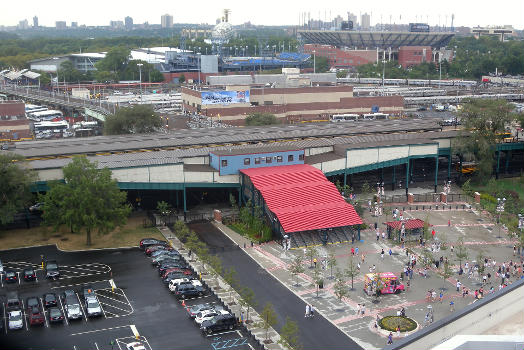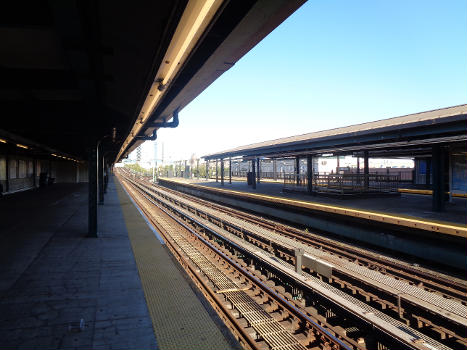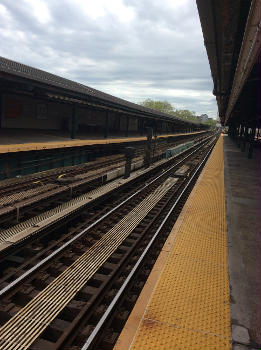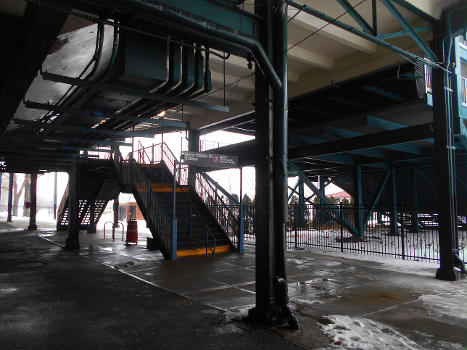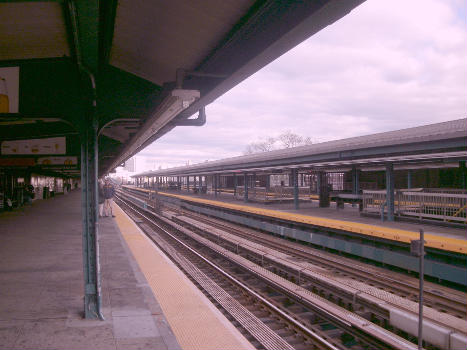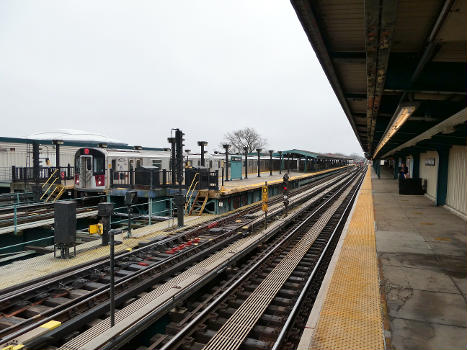General Information
| Completion: | 7 May 1927 |
|---|---|
| Status: | in use |
Project Type
| Function / usage: |
Elevated metro or light rail station |
|---|---|
| Material: |
Steel structure |
Location
Technical Information
Dimensions
| number of tracks | 3 | |
| track gauge | 1 435 mm | |
| platforms | number | 3 |
Excerpt from Wikipedia
Mets–Willets Point (formerly Willets Point–Shea Stadium) is an express station on the IRT Flushing Line of the New York City Subway. It is served by the 7 train at all times and by the <7> train rush hours in the peak direction or after sporting events. This station is located in Flushing Meadows–Corona Park in Willets Point, Queens, on Roosevelt Avenue between 114th and 126th Streets.
The station was originally opened as a local station, Willets Point Boulevard, in 1927. It was rebuilt into the current layout of three tracks, two side platforms, and a center island platform for the 1939 New York World's Fair. The station's peak use occurs during Mets games at Citi Field (and at Shea Stadium from 1964 until 2008), located on the north side of the station, and during events at the USTA National Tennis Center, on the south side.
History
Construction and opening
The 1910 Dual Contracts called for extending IRT and BMT lines to Brooklyn, Queens, and the Bronx. Queens did not receive many new IRT and BMT lines compared to Brooklyn and the Bronx, since the city's Public Service Commission (PSC) wanted to alleviate subway crowding in the other two boroughs first before building in Queens, which was relatively undeveloped. The IRT Flushing Line was to be one of two Dual Contracts lines in the borough, and it would connect Flushing and Long Island City, two of Queens' oldest settlements, to Manhattan via the Steinway Tunnel. When the majority of line was built in the early 1910s, most of the route went through undeveloped land, and Roosevelt Avenue had not been constructed.:47 Community leaders advocated for more Dual Contracts lines to be built in Queens to allow development there.
The original Willets Point Boulevard station opened on May 7, 1927. At that time, it was located at the intersection of Willets Point Boulevard, 126th Street, and Roosevelt Avenue and was a minor, local stop on the Flushing Line. Trains terminated at this station, with a shuttle bus to Flushing until that town's subway station could be built. On January 22, 1928, the station at Flushing opened, and Willets Point Boulevard became an intermediate station on the line.
Renovations
By December 1936 it was planned that for the additional crowds of the 1939 New York World's Fair that the station would be turned into a 3-platform, 4-track station capable of serving 40 trains per hour in each direction. Expansion of the Willets Point Boulevard station, as well as the construction of an Independent Subway System line to a planned World's Fair station nearby, was seen as essential for World's Fair access. The Flushing Line, until then a two-tracked line, was retrofitted with a third track to provide express service to the fair. World's Fair Special express trains began service on April 24, 1939.
In 1950, a proposal to divert some buses' terminals from Flushing to Willets Point faced great opposition. Most of the opposition focused on the lack of business for Flushing business owners near the bus terminals there, as well as the increased travel times from Willets Point to points east. Supporters of the plan noted the heavy traffic congestion on Flushing streets and the narrowness of the stairways at the Main Street station.
The platforms at Willets Point Boulevard were extended in 1955–1956 to accommodate 11-car trains.
The northbound side platform and its ramp were added for the 1964 World's Fair, also held in Flushing Meadows; the station was renamed Willets Point–Shea Stadium when the Shea Stadium was built soon afterward. Today, remnants of the original 1927 station can be seen just east of the current station. Ironwork indicates where the old side platforms had been, and parts of the former fare entry area remain. The southbound side platform is also noticeably longer than the 11-car IRT-length trains that serve it; a long segment east of the current passenger waiting area—part of the original southbound platform—has fallen into disrepair and has been gated off.
Mets service
Express service to Manhattan at the conclusion of New York Mets weeknight games was first introduced in July 2007, followed by express service to Manhattan at the end of all Mets weeknight and weekend games in April 2008. The "super" express trains run for approximately one hour and only make three stops in Queens before entering Manhattan: 61st Street–Woodside, Queensboro Plaza, and Court Square. After baseball games, Manhattan-bound local trains stop at the southbound side platform, while Manhattan-bound express trains and Main Street-bound trains both stop at the island platform.
Following the closure and demolition of Shea Stadium, the Metropolitan Transportation Authority simply renamed the stop Mets–Willets Point, omitting the corporate-sponsored name associated with the current stadium. The MTA was unsuccessful in achieving a similar naming rights deal and would not post the name for free. Had the naming rights deal been achieved, the station would have been known as Willets Point–Citi Field.
AirTrain station
On January 20, 2015, New York Governor Andrew Cuomo announced a plan to build an AirTrain LaGuardia people mover, running along the Grand Central Parkway. This people mover would connect the station to LaGuardia Airport. In January 2017, the Port Authority of New York and New Jersey (PANYNJ) released its 10-year capital plan that included AirTrain LaGuardia funding.:35 On February 6, 2017, the PANYNJ announced that it had opened a four-week-long request for proposals to design three AirTrain stations, including the Willets Point station, as well as plan the right of way from Willets Point to the airport. In May 2017, Parsons Brinckerhoff was hired to design the AirTrain. Construction is projected to start in 2019, with passenger service in 2023.:35
Station layout
This three-track express station has a layout unique in the system. From compass north to south, it is arranged: southbound side platform, southbound local track, center express track used for northbound service only, island platform, northbound local track, northbound side platform. The Fordham Road station on the IND Concourse Line in the Bronx has a similar layout: a split island platform as well as an unsplit island platform, but the Mets–Willets Point station is the only station in the subway system with this particular setup.
Trains running northbound (toward Main Street) normally open their doors on the island platform. The northbound side platform is used only during Mets games and events at the National Tennis Center, such as the U.S. Open.
Some evening rush hour 7 local trains terminate at this station by using the express track. West of the station, there are switches between the local tracks, the express track, and the northern layup track to 111th Street. East of the station, switches allow trains on the express track in either direction to switch to the local track, but not vice versa.
Exits
On the south side of the station, an ADA-accessible ramp connects the mezzanine and the northbound (southern) side platform to a footbridge, known as the Passarelle Boardwalk, which passes over Corona Yard and connects to the Mets–Willets Point station on the Long Island Rail Road's Port Washington Branch, before entering the grounds of the National Tennis Center. A full-length wooden mezzanine is located underneath the tracks and platforms. There are stairways from the island platform to the mezzanine, and two non-ADA-accessible ramps from the southbound (northern) side platform to the mezzanine. The north side of the station has a stairway leading directly to Citi Field's Jackie Robinson Rotunda.
Accessibility
In 2009, the northbound side platform became ADA-accessible to passengers with disabilities. The MTA built a $4 million ramp from the south side of Roosevelt Avenue to the station mezzanine; the two existing ramps from the mezzanine to station level were modified to make them ADA-accessible. The ramps are owned and maintained by the New York City Department of Parks and Recreation.
Some riders with disabilities were unhappy that the station was not made completely accessible during the station's renovation. By contrast, other New York City Subway stations that serve sports venues, including 161st Street–Yankee Stadium for Yankee Stadium, 34th Street–Penn Station at Seventh Avenue and Eighth Avenue for Madison Square Garden, and Atlantic Avenue–Barclays Center for Barclays Center, are completely accessible. Northbound local trains open their doors on the side platform during Mets games and special events only, and as a result, disabled passengers who need to take the Manhattan-bound 7 train during Mets games and special events must take a Flushing-bound train one stop to continue their trip. The southbound platform and the center platform are not wheelchair-accessible.
A footbridge had formerly extended north over Casey Stengel Plaza, leading to a long, circular staircase with turnstiles at the bottom, bringing people close to Gate E at Shea Stadium. In 2008, the footbridge and turnstiles were removed and replaced with a wider stairway which is now situated at Mets Plaza, close to Citi Field's Jackie Robinson Rotunda. The arrangement of turnstiles in the mezzanine was also reconfigured to improve the post-game pedestrian flows and allow fans to use all ramps, whether they were using the subway or walking across the Passarelle Boardwalk to reach the Long Island Rail Road station or parking lots in Flushing Meadows–Corona Park.
Text imported from Wikipedia article "Mets–Willets Point station (IRT Flushing Line)" and modified on June 2, 2020 according to the CC-BY-SA 4.0 International license.
Participants
Currently there is no information available about persons or companies having participated in this project.
Relevant Web Sites
- About this
data sheet - Structure-ID
20055921 - Published on:
24/03/2010 - Last updated on:
16/01/2025

